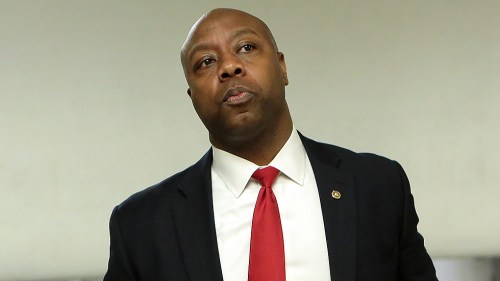GOP chances of winning the Senate on the rise
Senate Republicans have seen their chances of taking the Senate majority steadily rise this year as they have expanded the battlefield, limited internal fights and recruited a set of strong candidates.
It’s a remarkable shift from two years ago, when infighting between an out-of-power President Trump and the GOP establishment left the conference with midterm candidates who underperformed, boosting Democrats to a bigger majority in 2023 than they enjoyed the previous year.
The latest good news for Republicans came in Maryland and Montana.
In the deep-blue state, the GOP recruited former Gov. Larry Hogan as its Senate candidate. The popular Hogan’s decision to run gives Republicans a chance at an upset and at a minimum will force Democrats to spend money to keep a seat in their column.
In Montana, Republicans convinced Rep. Matt Rosendale to exit the GOP primary, providing a clearer path to the nomination for businessman Tim Sheehy, the candidate preferred by Sen. Steve Daines (R-Mont.), who is chairing the Senate Republican campaign team.
In an important show of unity, both the Republican Senate campaign arm and Trump threw their weight behind Sheehy, joining forces in the effort to unseat the Democratic incumbent, Sen. Jon Tester.
Even before those developments, the GOP looked like the favorite to take back the Senate.
Democrats are defending 23 seats this cycle, including in red states such as Montana, West Virginia and Ohio, where Trump, the likely GOP presidential nominee, is expected to coast to a victory over President Biden.
In West Virginia, incumbent Sen. Joe Manchin (D) announced his retirement last year, all but securing the seat for the GOP.
“This is a good map for Republicans,” said Dave Peterson, a political science professor at Iowa State University. “There’s a long way to go, and a lot of other primaries out there that could hurt them. But I think this is a good year for them.”
David McCuan, a political science professor at Sonoma State University, said it is the GOP’s chamber to lose at this point.
“One reason that it’s still their chamber to lose is because they’ve been able to expand the map, and Democrats are unable to expand the map, they have to protect the map. So fundamentally, at base, Democrats are in a protect mode, and Republicans are in an expansive mode. Republicans remain on offense,” he said.
Republican strategists are growing more and more bullish about their odds.
“This is a really good map that Republicans know they have to take advantage of, not only because of the electoral atmospherics, but because they generally don’t line up this way,” said Republican strategist Ford O’Connell.
Democrats are heading into the race for the Senate with a 51-49 majority, meaning Republicans could flip just one seat and earn the majority if their presidential candidate wins the White House.
With Manchin out and West Virginia Gov. Jim Justice (R) running for his seat, Republicans feel like they already have 50 seats.
If they can take out Tester or Sen. Sherrod Brown (D) in Ohio, they’ll be at 51. Both seats are considered “toss-ups” by the nonpartisan Cook Political Report, along with Arizona, where a three-way contest may take place among Republican Kari Lake, Democratic Rep. Ruben Gallego and Sen. Kyrsten Sinema (I-Ariz.) — if the incumbent chooses to run for reelection.
Another four Senate races in which Democrats are defending seats in Michigan, Nevada, Pennsylvania and Wisconsin are rated as “lean Democratic.”
Republicans, in contrast, are only defending two seats that are seen as remotely competitive. They are held by Sen. Rick Scott in Florida and Sen. Ted Cruz in Texas. Cook rates the two races as “likely” Republican, a step more secure from the “lean Democratic” races where Democrats are playing defense.
The presidential contest also has Republicans feeling optimistic about the Senate.
While a likely race between Trump and Biden remains a coin toss, a number of polls have shown Trump with an edge both nationally and in key swing states such as Michigan.
Trump leads Biden 44.4 percent to 41.7 percent in the average of national polls maintained by The Hill/Decision Desk HQ. In Michigan, Trump has a 2.6 point lead over Biden in The Hill/DDHQ average. In Pennsylvania, Trump has a 2.8 point lead in the same average.
Democratic Senate candidates can still win races in such an atmosphere, but it potentially provides additional pathways for the GOP to get to the majority or grow it.
“You already have a pretty clear path to 50. What you’re focused on now is adding additional seats for when it comes time to move legislation through the Senate,” said one GOP operative with experience working on Senate races.
“Senate Republicans have to still run through the tape and add at least one more seat to guarantee themselves a majority regardless of the presidential outcome, and some of the recent developments bolster their hopes at doing just that,” the operative added.
There are a few possible bumps in the road for Republicans.
Tester and Brown, in particular, are veteran Democratic senators who have repeatedly been seen as election-year targets, only to win in the end. Daines has been careful with his words, like a coach who does not want to provide locker room board material for a rival.
In January, Daines told reporters that “you can’t fall in love with this map” and noted that the GOP contenders face “some very strong incumbent Democrat senators who know how to win in red states.”
The Senate GOP campaign arm is staying neutral in Ohio, where a crowded primary field of Republicans is looking to challenge Brown. It’s unclear who among them will emerge as the Republican nominee.
In Pennsylvania, Sen. Bob Casey (D) is running stronger than Biden. A recent Emerson College/The Hill survey from the state found Casey leading his likely Republican rival David McCormick by almost 10 points.
Peterson stressed that it remains early in the cycle, and that if Biden’s numbers start to rebound and the economy continues to improve, Democrats could see an enthusiasm boost.
Still, there are also reasons for Democrats to be nervous.
McCuan noted that states like Nevada and Wisconsin, which have been trending blue in polls at the presidential level, could be “somewhat problematic” for Democrats.
“Part of this is the drag by the president, but also the border issue seems to play heavily in those states,” he said.
Hogan’s entrance into the Maryland Senate race has definitely given the GOP a jolt. A recent Emerson College Polling/The Hill/DC News Now survey found Hogan leading or tied with the two most likely Democratic nominees.
Democrats were already on alert in redder states, but Hogan’s Maryland bid “put the Democrats back on their heels in a race they never expected to have a problem with,” said Republican strategist Mike Dennehy.
“He’s a Republican who has proven that he can get elected in a blue state. So regardless of the presidential race, Larry Hogan is going to be very strong and very competitive,” Dennehy said.
Peterson, the Iowa State professor, said he’s “still skeptical” that the party can flip Maryland, but that “it looks better for them than it did a couple of weeks ago” after Hogan’s entry.
Some Democrats acknowledge the challenges they face heading into November.
“It will be difficult for the Democrats to hold on,” said Democratic strategist Hank Sheinkopf.
At the same time, Republicans run the risk of overestimating Biden’s low polling numbers and getting overconfident about their pickup opportunities, Sheinkopf suggested.
Democrats’ Senate campaign arm, the Democratic Senatorial Campaign Committee, is projecting confidence that it can extend their record of winning “every statewide federal election in Maryland for 44 years,” even with Hogan in the race, and said they’re “thrilled” with the National Republican Senatorial Committee’s move to back Lake in Arizona, calling her “the perfect candidate — to lose the race.”
O’Connell, the Republican strategist, said the GOP needs to lock in on efforts to get out the vote and coordinate fundraising, “because the Democrats are going to throw the kitchen sink at these Republicans, because they know what’s at stake, whether or not they’re saying it out loud.”
Al Weaver contributed.
Copyright 2023 Nexstar Media Inc. All rights reserved. This material may not be published, broadcast, rewritten, or redistributed. Regular the hill posts












